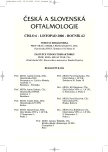Dry Eye Syndrome in Patients with Conjunctival Concretions
Syndrom suchého oka u nemocných se spojivkovými konkrementy
Cíl:
Zjistit možný vztah mezi přítomností spojivkových konkrementů a poruchou stability slzného filmu.
Soubor a metodika:
Soubor byl tvořen 50 asymptomatickými nemocnými s náhodně zjištěnými spojivkovými konkrementy, kteří se dostavili na všeobecnou ambulanci Oční kliniky VFN s převážně refrakčními obtížemi. Věk souboru se pohyboval mezi 24 až 69 lety (∅ 44,1 let). U 35 nemocných (skupina A) byly přítomny jen spojivkové konkrementy, u zbývajících 15 (skupina B) spolu s konkrementy byla zjištěna i dysfunkce Meibomských žlázek. Bylo provedeno kompletní oční vyšetření včetně podrobné analýzy tarzálních spojivek i spojivek firnixů. Schirmerův test I, BUT a barvení Bengálskou červení. U 5 nemocných byl využit MFT – mucin ferning test („kapradinový“ test).
Výsledky:
Pokročilý až těžký deficit slz (< 10 sekund/5 min) byl zjištěn u 42,8 % nemocných skupiny A a 46,6 % nemocných skupiny B. BUT byl zkrácen nebo výrazně zkrácen (< 10 sekund) u 51,4 % nemocných skupiny A a 60 % nemocných skupiny B. Patologické barvení Bengálskou červení nebylo zaznamenáno ani u jednoho nemocného. MFT byl normální u všech 5 vyšetřovaných jedinců (klasifikace I a II).
Závěr:
U nemocných se spojivkovými konkrementy dochází k poruše slzného filmu (snížené hodnoty Schirmerova testu a BUT). Doba potřebná k roztržení slzného filmu (BUT) je překvapivě nižší u mladších jedinců (do 45 let), a to i u nemocných bez dysfunkce Meibomských žlázek. U starších nemocných (nad 45 let) se více projevuje defekt vodné složky. Jedince se spojivkovými konkrementy je možno zařadit mezi potenciálně postižené syndromem suchého oka.
Klíčová slova:
spojivkové konkrementy, suché oko, Schirmerův test, BUT, Bengálská červeň, MFT
Authors:
P. Haicl; H. Janková; K. Jirsová 1
Authors‘ workplace:
Oční klinika VFN s 1. LF UK, Praha
přednosta doc. MUDr. B. Kalvodová, CSc.
; Oční tkáňová banka a laboratoř Oční kliniky VFN
vedoucí Mgr. K. Jirsová, PhD.
1
Published in:
Čes. a slov. Oftal., 62, 2006, No. 6, p. 415-422
Overview
Purpose:
To establish the possible correlation between the presence of conjunctival concretions and the instability of the tear film.
Methods:
The group consisted of 50 asymptomatic patients with accidentally detected conjunctival concretions, presented mostly for refractive errors at the outpatient department of the Department of Ophthalmology, School of Medicine Hospital, Prague, Czech Republic. The age of the patients ranged 24–69 years, mean 44.1 years. In 35 patients (group A) were present the conjunctival concretions only, in the remaining 15 patients (group B), together with the concretions, the Meibomian glands dysfunction was also discovered. The complete eye examination was performed, including detailed analysis of tarsal conjunctiva and fornices, Schirmer’s test I, the tear film break-up time (BUT) and rose bengal staining. In five patients, the mucin ferning test (MFT) was also performed.
Results:
Advanced to severe tear deficiency was detected in 42.8 % of patients of the group A, and in 46.6 % of patients in the group B respectively. BUT was shorter or extremely shorter (< 10 sec) in 51.4 % of patients in the group A and in 60 % of patients in the group B. The pathological staining with bengal rose was not detected even in a single patient. MFT was normal in all 5 examined patients (classification I and II).
Conclusion:
In patients with conjunctival concretions, the tear film deficiency may be present (decreased values of the Schirmer’s test and BUT). The tear film break-up time (BUT) is surprisingly shorter in younger patients (younger than 45 years of age), in patients with and also without Meibomian glands dysfunction as well. In older patients (over 45 years of age), the defect of the aqueous layer is more pronounced. Patients with conjunctival concretions are potentially affected with the dry eye syndrome.
Key words:
conjunctival concretions, dry eye, Schirmer’s test, the tear film break-up time (BUT), bengal rose staining, mucine fehrning test (MFT)
Labels
OphthalmologyArticle was published in
Czech and Slovak Ophthalmology

2006 Issue 6
Most read in this issue
- Chronic Postoperative Endophthalmitis
- Dry Eye Syndrome in Patients with Conjunctival Concretions
- Epidemiology of the Endocrine Orbitopathy
- Long-term Functional Effect of Pars Plana Virtrectomy in Complications of Prolipherative Diabetic Retinopathy
